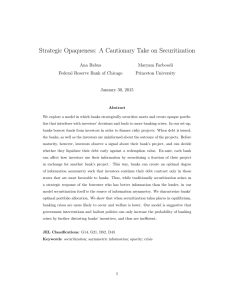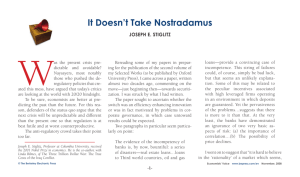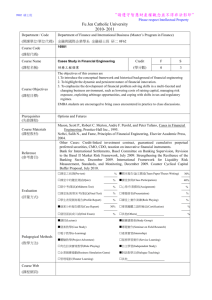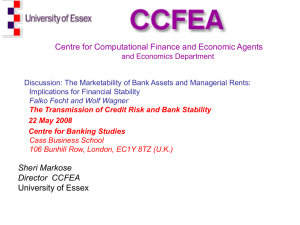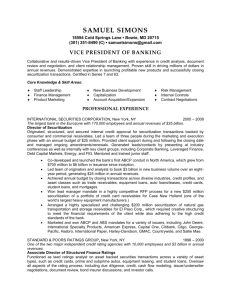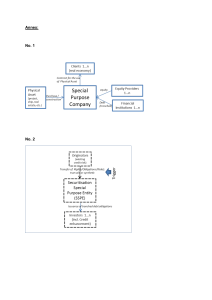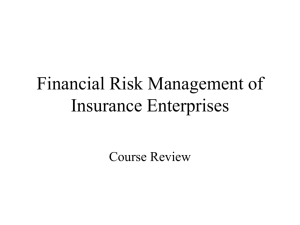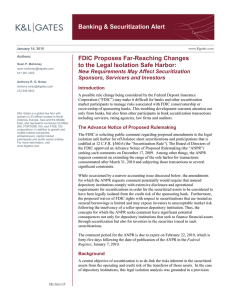Re-thinking Our Financial System
advertisement
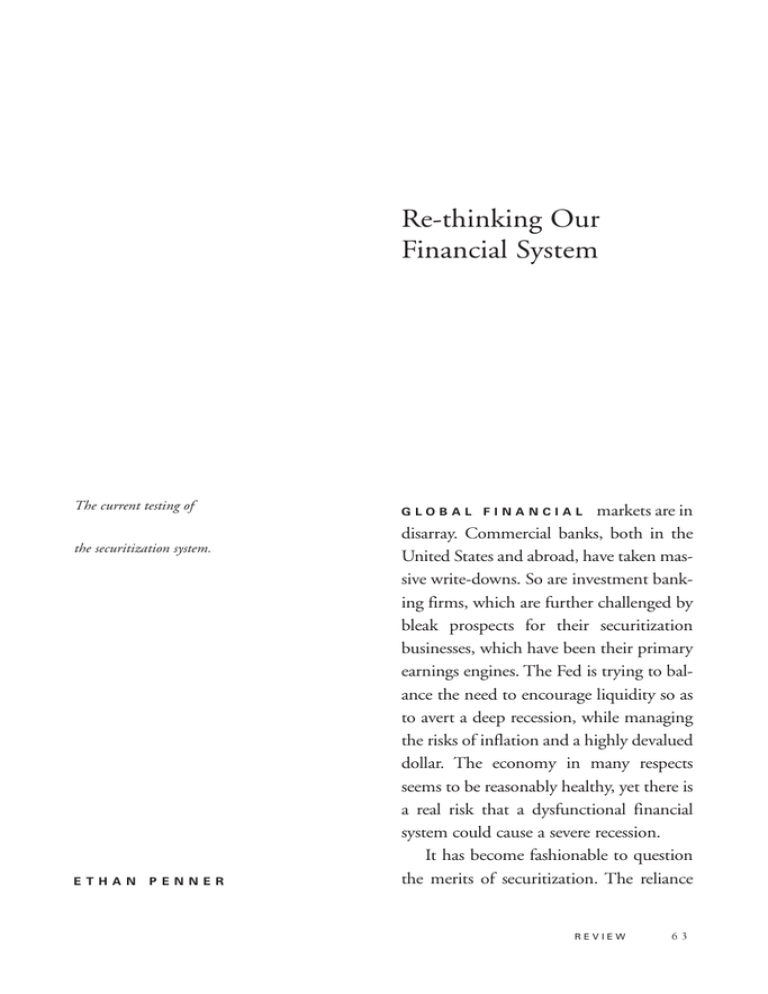
Re-thinking Our Financial System The current testing of the securitization system. ETHAN PENNER G L O B A L F I N A N C I A L markets are in disarray. Commercial banks, both in the United States and abroad, have taken massive write-downs. So are investment banking firms, which are further challenged by bleak prospects for their securitization businesses, which have been their primary earnings engines. The Fed is trying to balance the need to encourage liquidity so as to avert a deep recession, while managing the risks of inflation and a highly devalued dollar. The economy in many respects seems to be reasonably healthy, yet there is a real risk that a dysfunctional financial system could cause a severe recession. It has become fashionable to question the merits of securitization. The reliance REVIEW 63 that investors place upon the risk assessments of the three rating agencies is now ridiculed. Also under scrutiny is how the system permits complete risk transference from the originators, which include both the asset originator and the Wall Street dealer communities, to the bond buyer, violating the “skin in the game” precept that is valued so highly in the investment business. Finally, there are those who believe that having to mark asset values to market daily can lead to undue panic, exacerbating market downturns. Those in the anti-securitization camp have correctly traced the boom in securitization to the Basel Accord of 1988, which introduced risk-based capital guidelines to the commercial banking industry, encouraging banks to hold highly rated securities rather than loans, as they are required to hold more equity capital against assets thought to possess more risk. There is little doubt that these regulatory changes, which happened in response to the S&L’s FIRREA legislation and mirrored the capital requirements of that legislative change, greased the wheels for the historical shift from a bank deposit/portfolio lending finance model, to a dealer/bond-centric securitization model. While the current crisis has revealed flaws in the securitization model, I do not agree with the popular conclusion that this shift was bad. As a model of finance, the bank deposit/portfolio lending model possesses 64 ZELL/LURIE REAL ESTATE CENTER shortcomings when compared to the securitization model. These include: encouraging a huge duration mismatch in the system (short-term deposits funding longer term assets); lacking mark-to-market requirements, which reduces transparency and allows problems to fester and grow over long periods (for example, Japan in the past two decades); providing capital at a higher rate, as risk is not separated into more and less risky classes; and placing access to capital in the hands of a few, thereby reducing merit-based, entrepreneurial access to capital and reversing the democratization of access to capital that securitization fosters. I believe that our financial system is in trouble the like of which I have never seen, and, as a result, the system will inevitably undergo a transition. We are in uncharted waters, and mines have been exploding all over the world in the form of Conduits, SIVs, SIV-lites, and so on. The wealth that has been created by increases in home values during the past decade seems to be at grave risk for being completely reversed. The value of the dollar has dropped and, unbelievably, our status as the leader of global finance appears shaky. Given the global geopolitical state of affairs, this could not have happened at a worse time. There have been predictable calls for government intervention. In November we saw Congress and some mortgage professionals calling for legislating an increase in the role that FNMA and FHLMC can play in helping out the system. Within weeks of these calls, both entities announced multi-billion dollar losses and seemed themselves to be on the brink of requiring a bailout. We have seen government inquiries, as well as the threat of litigation, regarding the role that securitizers—Wall Street’s largest firms—played in the subprime origination mismanagement. The role played by the three major rating agencies is likewise under scrutiny. These investigations are sure to have a dampening effect on credit availability. So are some of the Congressional proposals regarding the subprime crisis, such as the proposal to allow a mortgagor better protections through the bankruptcy court. Our leadership, both governmental and financial, is struggling with the challenge of how to right the financial system and what that system should look like going forward. We will inevitably see regulatory change that will have a powerful impact on the financial landscape. What we do not need is to go backwards in our financial evolution. For the reasons mentioned above, securitization must remain an important component of our financial system, perhaps even its lynchpin. More intelligent oversight and rules must be introduced to protect those with limited tolerance for capital risk, such as the bulk of our pension system. This means we must ensure that a AAA rating honestly reflects a near-zero capital risk investment. While it is tempting to return such investments to the banking world in the form of insured deposits, the reality is that we’ve been there before. We have learned from the S&L crisis and the Japanese banking crisis that rather than insulate risk, the insured deposit-based system of finance, with its lack of transparency, encourages bank executives to take risks to increase earnings (and their bonuses) while laying the risk at the feet of taxpayers. The Basel Accord has done a decent job of introducing the concepts of risk-based pricing, thus ensuring that the banking system functions in a healthy manner. Many banks around the world, such as the German landesbanks that have not been held to the same riskbased capital standards as the U.S. banks have mispriced risk and are now paying a price for their actions. One could argue, however, that the Basel Accord didn’t go far enough. Specifically, it did not anticipate all of the off-balance sheet risks that now exist thanks to the proliferation of derivatives over the past two decades. Reading about how unlikely investors such as German and Asian banks and European insurance companies have continued to be surprised at their exposures to the REVIEW 65 U.S. home mortgage market provides ample illustration. The virtually overnight stoppage of the securitization business that began last summer—correctly called a “bondbuyer’s strike”—reflects one of the most significant strengths of the system. Because of the increased transparency of the market, in which once a single deal fails to clear the market it can impact a change on the whole business, the securitization business maintains a self-corrective mechanism. And, as we are witnessing, the correction can be vicious and swift. I’d hasten to add that were we to have experienced the prolonged bull market of the past decade, which led to the inevitable relaxing of lending underwriting guidelines in a portfolio-lending dominated marketplace, the transition would have been much slower and today’s bad debt problem would be much greater. Securitization is experiencing its first real test. Clearly there will be modifications and adjustments. Yet there will surely continue to be a significant role for securitization. This is a time for thoughtful regulatory oversight, not the time to throw the baby out with the bathwater. 66 ZELL/LURIE REAL ESTATE CENTER
